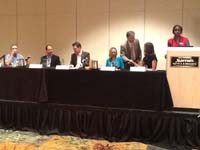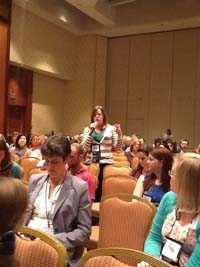Diagnosis for Classroom Success, Teacher Edition: Making Anatomy and Physiology Come Alive
—Author Nicole Maller
—Author Nicole Maller
By Mary Bigelow
Posted on 2013-04-14
By Mary Bigelow
Posted on 2013-04-13
At a session this morning, when the presenters described the agenda it was not exactly what was described in the program. I was already familiar with the topic, so I slipped out. Since other sessions had already started, I decided to use the time on the exhibit floor. As I was browsing, I stopped at the booth of the Royal Society of Chemistry and struck up a conversation with another attendee.I found out that he had worked with Don Herbert, TVs Mister Wizard. Mr. Wizard was one of my childhood heroes, so I felt a connection. He also mentioned that one of his science instructors had himself been a student of Marie Curie’s. So I know someone who knew someone who knew Marie Curie! Another distant connection. But those who met Bill Nye on Thursday have a direct connection to a science superhero!
Other connections are geographical. I met educators from all over the US, as well as Nova Scotia, Ontario, Alberta, the UK, Australia, the Bahamas, and Taiwan!
At a session this morning, when the presenters described the agenda it was not exactly what was described in the program. I was already familiar with the topic, so I slipped out. Since other sessions had already started, I decided to use the time on the exhibit floor. As I was browsing, I stopped at the booth of the Royal Society of Chemistry and struck up a conversation with another attendee.I found out that he had worked with Don Herbert, TVs Mister Wizard. Mr. Wizard was one of my childhood heroes, so I felt a connection.
By Lauren Jonas, NSTA Assistant Executive Director
Posted on 2013-04-13
 “It’s IMPOSSIBLE not to love science!” That’s what Dr. Rui Vogt Aives de Cruz told a group of several hundred science teachers Thursday at NSTA’s National Conference on Science Education. He and four other representatives from some of America’s top STEM employers urged them to communicate that message to their students.
“It’s IMPOSSIBLE not to love science!” That’s what Dr. Rui Vogt Aives de Cruz told a group of several hundred science teachers Thursday at NSTA’s National Conference on Science Education. He and four other representatives from some of America’s top STEM employers urged them to communicate that message to their students.
Moderated by NSTA’s Executive Director Dr. David L. Evans, NSTA’s New Science Teacher Academy hosted a roundtable discussion focused on how we make science real for students, and how we can connect scientists with students. Speakers included Dr. Larry Sernyk, from Dow; Dr. Mark Land, from Bayer; Dr. Rui Vogt Aives de Cruz, from Dow; Amy L. Gowder , from Lockheed Martin; and Jenny M. Kite, from Astellas.
 Why is this important? Jenny M. Kite told us what we all need to remember: Students will drive tomorrow’s innovation! Amy L. Gowder explained that 75% of Lockheed Martin employees need a science background, they need engineers, and it’s critical to the future of their company to have a pipeline. Rui Vogt Aives de Cruz made his passion for STEM clear and urged teachers to communicate their love of science to students, to show how science is applicable to their lives. Mark Land from Bayer (“we’re more than just aspirin!”) credited great teachers for getting him where he is today. Larry Sernyk from Dow echoed the praise for teachers, saying they were vital to his career.
Why is this important? Jenny M. Kite told us what we all need to remember: Students will drive tomorrow’s innovation! Amy L. Gowder explained that 75% of Lockheed Martin employees need a science background, they need engineers, and it’s critical to the future of their company to have a pipeline. Rui Vogt Aives de Cruz made his passion for STEM clear and urged teachers to communicate their love of science to students, to show how science is applicable to their lives. Mark Land from Bayer (“we’re more than just aspirin!”) credited great teachers for getting him where he is today. Larry Sernyk from Dow echoed the praise for teachers, saying they were vital to his career.
So what were some of the suggestions? If a teacher wants to approach a company to see if they can make connections between scientists and students, the panel recommended that teachers do a little legwork in advance—really think about what you want to accomplish and how a scientist could help. For instance, do you want someone to talk at career day? Or would you like your class to have a tour of a lab? Do you want them to explain how they got where they are? Are you looking for a specific kind of scientist who can explain a topic to your class?
The teachers asked questions, such as “How can you get students interested who may not pursue a 4-year degree”? The panel had a host of ideas—among them to let students shadow a scientist, and to show them careers that require STEM training, but not necessarily a 4-year degree. And in fact, when students start out pursuing a technical degree and become enthralled with the subject, they often go on to get a 4-year degree, or even go beyond.
The take-home message was for teachers to bring fresh ideas. Teachers know best what will appeal to students, and they should share them with companies that require their workers to have STEM training.
To learn more about the New Science Teacher Academy, which brings together these innovative companies and new science teachers, please go to: http://www.nsta.org/academy/. If you are a new science teacher or know someone who is, please consider the fellowship program—they are now accepting applications!
By Mary Bigelow
Posted on 2013-04-12
 It’s understandable that conference-goers are tired at the end of the day. The Henry B. Gonzalez Convention Center is huge, and fortunately the schedulers built in some time to trek from one session to another. With the gorgeous weather, it’s not a burden to get to sessions at a neighboring hotel. The downtown is compact and very walkable.
It’s understandable that conference-goers are tired at the end of the day. The Henry B. Gonzalez Convention Center is huge, and fortunately the schedulers built in some time to trek from one session to another. With the gorgeous weather, it’s not a burden to get to sessions at a neighboring hotel. The downtown is compact and very walkable.
Unlike some other organizations’ conferences I’ve attended, NSTA presenters like to get their audience members actively engaged, working together, and sharing ideas. I was at three such sessions today, and it’s both exhilarating and exhausting. I started the day with one that focused on helping students (especially English language learners) with science vocabulary. The presenters had us talking about the concepts and manipulate words and pictures using various organizers. As I walked around, I saw that even the hallways became venues for collaboration.
And at the end of the day, a stroll along the Riverwalk is a great way to relax. On my way back to the hotel, I was surprised to see yellow-crowned night herons in the trees, not surprised to see (and hear) great-tailed grackles, and added the white-winged dove to my birding life list!
 It’s understandable that conference-goers are tired at the end of the day. The Henry B. Gonzalez Convention Center is huge, and fortunately the schedulers built in some time to trek from one session to another. With the gorgeous weather, it’s not a burden to get to sessions at a neighboring hotel. The downtown is compact and very walkable.
It’s understandable that conference-goers are tired at the end of the day. The Henry B. Gonzalez Convention Center is huge, and fortunately the schedulers built in some time to trek from one session to another. With the gorgeous weather, it’s not a burden to get to sessions at a neighboring hotel. The downtown is compact and very walkable.
By Lynn Petrinjak
Posted on 2013-04-12
I started the morning with a visit to the Elementary Extravaganza. So much activity was going on. I overheard one attendee exclaim, “I didn’t know we had so many elementary teachers!”
I’m not sure if he meant in Texas or in NSTA!
I also attended Mireya Mayor’s feature presentation,”My Wild Life.” She is a field researcher, TV personality, and mother. Her passion and dedication to science and science education were inspiring. I learned about the differences between lowland gorillas and mountain gorillas… the photos of the lemur she helped discover were adorable.
I started the morning with a visit to the Elementary Extravaganza. So much activity was going on. I overheard one attendee exclaim, “I didn’t know we had so many elementary teachers!”
I’m not sure if he meant in Texas or in NSTA!
By Mary Bigelow
Posted on 2013-04-11